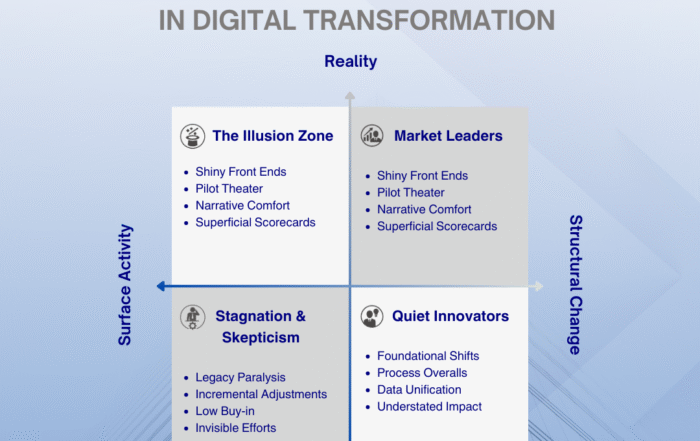
Smart planning with open standards, data portability, and modular design helps banks stay flexible and avoid vendor lock-in.
TL;DR – Why banks that skip optimization often regret it
- System Downtime Derails Operations – Poorly executed transformations can freeze core services like payments, loans, and account access.
- Financial Losses Add Up Fast – Missed transactions, emergency fixes, and churned customers cut deep into the bottom line.
- Reputation Takes a Hit – Customers don’t care about your upgrade—they care when their banking doesn’t work.
- Regulatory Risks Skyrocket – Compliance gaps during transformation can trigger fines, scrutiny, and legal fallout.
- Why It Matters – Failing to plan for failure is planning to fail. Safeguard your transformation with strong risk, testing, and communication strategies.
The High Cost of Overlooking What You Already Have
Have you ever torn down a perfectly good house because the kitchen needed updating? That’s what skipping core optimization can feel like. In the rush to modernize, some banks get caught up in the allure of a total core replacement, thinking it’s the fastest way to leap into the digital future.
But here’s the catch: jumping straight to a full replacement without optimizing your current system often leads to more risk, higher costs, and plenty of headaches. The smart money? It’s on getting the most out of what you already have before making any big moves.
Let’s break down why skipping optimization can backfire—and how a more thoughtful approach can keep you ahead of the curve without falling off the financial cliff.
1. Higher Operational Risks: Fix Before You Replace
What Some Banks Get Wrong:
- They assume a brand-new core system will magically fix everything.
- They underestimate the operational risk of swapping systems mid-flight.
- They ignore the fact that unoptimized processes will bog down even the best tech.
The Reality:
A full core replacement is like open-heart surgery—you want the patient as healthy as possible before going under the knife. Replacing a core system without first optimizing workflows and processes can expose your bank to significant operational risks, including downtime, service disruptions, and even data integrity issues. (Source: Deloitte)
What Smart Banks Do Instead:
- Stabilize and optimize your current system first. Think of it as prehab before major surgery.
- Audit your processes to figure out where the real bottlenecks are—it’s not always the tech.
- Take an incremental approach—modernize in stages to avoid breaking what’s working.
2. Skyrocketing Costs: You’ll Pay More If You Skip Steps
What Some Banks Get Wrong:
- They think starting from scratch is more cost-effective.
- They forget about the hidden costs: integrations, staff training, data migration.
- They underestimate the financial toll of delays and scope creep.
The Reality:
Core replacements are notoriously expensive—and full of unforeseen expenses. Finextra reports that banks often find themselves millions over budget because they failed to account for the complexities of integrating a new system with existing infrastructure.
What Smart Banks Do Instead:
- Run a cost-benefit analysis: How much ROI can optimization deliver compared to a full replacement?
- Consider hybrid approaches: Modular upgrades or cloud add-ons can deliver big wins without big risks.
- Budget wisely: Don’t forget to include training, change management, and ongoing maintenance.
3. Missed Opportunities for Quick Wins
What Some Banks Get Wrong:
- They see core transformation as an all-or-nothing proposition.
- They ignore the potential of incremental improvements that drive real results—today.
- They assume legacy systems can’t handle modern digital capabilities.
The Reality:
You don’t need a brand-new engine to drive faster; sometimes, a tune-up does the trick. Banks that focus on optimizing existing systems often find they can launch new digital services faster and with less disruption, gaining quick wins that improve customer satisfaction along the way. (Source: BCG)
What Smart Banks Do Instead:
- Invest in continuous improvement: Tackle process pain points and optimize core functions before swapping out the engine.
- Adopt modular upgrades: Cloud-native solutions and APIs can extend your system’s life and capability.
- Unlock underused features: Many legacy systems have powerful tools that are often overlooked.
4. Overextended Teams: Transformation Fatigue Is Real
What Some Banks Get Wrong:
- They believe their teams can handle everything at once.
- They underestimate the strain on IT, ops, and customer service during a core replacement.
- They don’t factor in the mental toll of managing legacy and new systems side by side.
The Reality:
Transformation fatigue isn’t just a buzzword—it’s a real problem. Teams that are spread too thin end up with missed deadlines, burnout, and costly mistakes. BCG points out that overextended resources are a common cause of core transformation failures.
What Smart Banks Do Instead:
- Start with optimization: It relieves pressure on internal teams by delivering improvements without a massive overhaul.
- Cross-train employees early to reduce the learning curve.
- Use phased rollouts: Nobody needs an overnight changeover disaster on their hands.
5. Delayed Time-to-Market: Don’t Let “New” Slow You Down
What Some Banks Get Wrong:
- They assume a new core system will speed up product delivery from day one.
- They forget that full replacements can take years to implement.
- They miss how optimization can get them to market faster—today.
The Reality:
A full core replacement is a marathon, not a sprint. But customers don’t wait for IT projects to wrap up. Banks that focus on optimizing their current systems first often deliver new products and digital services faster, maintaining their competitive edge while larger transformations unfold. (Source: Finextra)
What Smart Banks Do Instead:
- Leverage cloud-based solutions and APIs to build new customer experiences without touching the core.
- Prioritize high-impact enhancements that improve the customer journey today.
- Adopt an agile mindset: Small changes can deliver big results—fast.
Final Thoughts: Why Smart Banks Optimize First
Skipping optimization can leave you facing higher costs, bigger risks, and slower progress. Smart banks take a step-by-step approach—optimize first, then evaluate if a full replacement is really necessary.
You don’t need to tear down the house when a renovation will do. Sometimes, a well-planned tune-up delivers exactly what’s needed, without the disruption of a full replacement.
Ready to See Where You Stand?
Take the OptimizeCore® Scorecard to assess your core system’s health and identify cost-effective opportunities to modernize.
Because sometimes the best way forward is smarter—not harder.
#CoreBankingTransformation #CoreBankingOptimization





